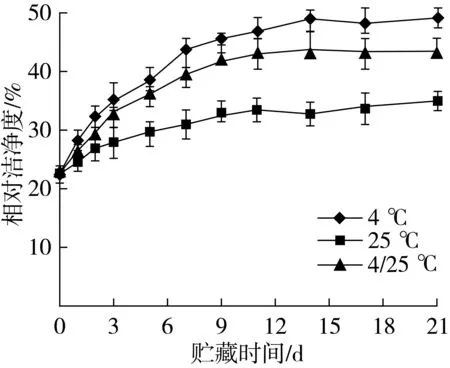不同储藏温度下重结晶锥栗淀粉的回生动力学
谢 涛 李 英
(湖南工程学院化学化工学院1,湘潭 411104)(湖南工程学院图书馆2,湘潭 411104)
不同储藏温度下重结晶锥栗淀粉的回生动力学
谢 涛1李 英2
(湖南工程学院化学化工学院1,湘潭 411104)(湖南工程学院图书馆2,湘潭 411104)
采用酶脱支-压热法复合处理制得重结晶锥栗淀粉,以相对结晶度(RC)、低温熔融焓(ΔHi)与玻璃化转变温度(Tg)为评价指标,研究了它们分别在4、25和4/25 ℃储藏过程中的回生动力学。结果表明:在不同储藏温度下,重结晶淀粉的RC、ΔHi随储藏时间延长而增加,而Tg则逐渐降低,且都在第11或14天达到平稳;在相同储藏时间里,不同储藏温度下重结晶淀粉的RC、ΔHi差别显著(以储藏在4 ℃的最高、25 ℃的最低),Tg的差别也比较显著(以储藏在25 ℃的最高、4 ℃的最低)。Avrami动力学分析表明,RC、ΔHi与Tg均可用于评价重结晶淀粉在储藏过程中的回生程度。
重结晶锥栗淀粉 储藏温度 理化特性 回生动力学
淀粉是由直链淀粉与支链淀粉组成的具有结晶与无定形结构的高分子聚合物。淀粉分子与水在加热时存在2个不同的相变过程,第1个是无定形区域的玻璃化转变,第2个是结晶区域的熔融转变[1]。在玻璃化转变温度(Tg)时,无定形区域在热作用下遭受二级相转变,由固定的玻璃态转化为黏性的橡胶态。在Tg下,淀粉分子运动性发生改变会显著影响淀粉基食品的稳定性[2-4]。淀粉回生是指糊化淀粉分子由无序态向有序态转化的过程[2]。评估淀粉回生的一种方法是使用X-射线衍射仪(XRD)测定淀粉的相对结晶度,完全糊化的淀粉不含结晶,此时淀粉的结晶区域已全部转化为无定形状态。在储藏过程中,无定形区域中无序的淀粉分子链结构也会转变为有序的结晶结构[5]。Avrami理论已被成功地应用于当晶核形成的淀粉起始回生阶段,也被用于测定一些淀粉凝胶的回生或重结晶速率[6-10]。先前许多淀粉回生的动力学研究主要集中在储藏过程中淀粉分子结晶度(RC)、支链淀粉低温熔融焓(ΔHi)与凝胶强度的变化[11-16]。本研究旨在阐明回生(或储藏)过程中淀粉分子的RC、ΔHi与Tg之间相互关系的基础上,研究在不同储藏温度下重结晶锥栗淀粉的回生动力学,从而为湿热变性淀粉的回生动力学研究提供基础科学依据,并且尝试用Tg也作为评估淀粉回生的指标。
1 材料与方法
1.1 材料、试剂与仪器
锥栗淀粉由实验室自制。普鲁兰酶(30 000 U/g):Sigma公司;其他试剂均为分析纯。D/max2500全自动X射线衍射仪:日本理学株式会社;DSC200型差示扫描量热分析仪:德国NETZSCH公司。
1.2 湿热处理锥栗淀粉的回生
用20 mmol/L醋酸-醋酸钠缓冲液配制20%(m/m)的淀粉乳,调节pH为5.0,沸水浴30 min。淀粉糊冷却至50 ℃与普鲁兰酶溶液混合(淀粉浓度11%(m/m),酶活50 U/g)反应20 h,在3 000 g离心10 min沉淀用冷去离子水洗涤,如此离心-洗涤2次。所得沉淀用去离子水配成30%(m/m)的淀粉乳,121 ℃压热处理30 min,将所得的凝胶状物冷却至25 ℃,密封储存在不同温度(4、25、4/25 ℃(表示4与25 ℃每24 h交替循环))下,分别在0、1、2、3、5、7、9、11、14、17、21 d取样进行X-射线衍射分析与差示扫描量热分析。
1.3 测定方法
参照文献[17]和文献[18]的方法,采用X射线衍射仪(扫描速率12°/min,扫描范围5°~60°,步长0.04,管压40 kV,管流30 mA)测定相对结晶度(RC),差示扫描量热分析仪(扫描温度范围为20~180 ℃,扫描速率为10 ℃/min,以空坩埚为参比,载气氮流速20 mL/min)分析玻璃化转变温度(Tg)和低温熔融焓(ΔHi)。
1.4 回生动力学分析

所有数据为3个平行试验的平均值,且采用SPSS 20.0进行显著性分析。
2 结果与分析
2.1 锥栗重结晶淀粉的相对结晶度
对不同储藏条件下锥栗重结晶淀粉的X-射线衍射图谱进行比对发现:在4 ℃储藏时,储藏0 d重结晶淀粉的晶型为A型,储藏第1~7天重结晶淀粉的晶型变为V型,储藏至第9天后转变为B型;在25 ℃储藏时,无论储藏多少天,重结晶淀粉的晶型始终保持A型不变;而在4/25 ℃储藏时,重结晶淀粉的晶型从储藏0 d的A型依次转变为第1~9天的V型、第11天后的B型,它们的相对结晶度(RC)的变化见图1。在不同储藏温度下,样品的相对结晶度随储藏时间延长而逐渐增加,在第11~14天达到最大。这种变化归因于糊化淀粉分子的重结晶,也即无序直链淀粉与支链淀粉的分子重排或重组[7]。而且,在相同储藏时间里,3个储藏温度下样品重结晶后的RC相互差别非常显著(P<0.01),以储藏在25 ℃的最低,相反以储藏在4 ℃的最高。这是因为在4 ℃储藏时淀粉分子的无定形区能够持有更多的水分而具有较好的移动性,从而强化了淀粉分子的重结晶过程,也即无定形区能满足持续形成更牢固结晶结构的条件;相反,在25 ℃储藏时因水分蒸发失去了形成稳定结晶结构的条件;在4/25 ℃储藏时,只有在4 ℃储藏期间才能满足形成更稳定结晶结构的条件,但这种条件随着25 ℃储藏期的到来以及反复次数的增多而逐渐受到削弱[8,11,19]。

图1 重结晶淀粉在储藏过程中相对结晶度的变化
2.2 锥栗重结晶淀粉的低温熔融焓与玻璃化转变温度
在不同储藏温度下,锥栗重结晶淀粉的低温熔融焓(ΔHi)与玻璃化转变温度(Tg)的变化见图2。从储藏第1天开始,在相同储藏温度下,重结晶淀粉的ΔHi逐渐增加而Tg逐渐降低,第14天时基本达到平稳。当储藏时间相同时,3个储藏温度下重结晶后样品的ΔHi差别显著(P<0.05),以储藏在25 ℃的最低,相反以储藏在4 ℃的最高;但3个储藏温度下重结晶后样品的Tg介于-2.1~-4.5 ℃之间,差别也比较显著(0.01 2.3 锥栗重结晶淀粉的回生动力学 在储藏1~11 d内,锥栗重结晶淀粉的RC、ΔHi与Tg随储藏时间延长而呈指数增加,可以采用Avrami方程进行描述(见表1)。由表1可知,无论测量哪个指标,其Avrami指数(n)都接近1(P>0.05),它可用于描述结晶模式,即晶核形成与晶体生长模式[8,9]。n值越接近1,表明淀粉凝胶在储藏过程中瞬时成核再结晶,继而晶体呈棒状生长[2,6,8]。速率常数(k)值在3个储藏温度下的差别较大(0.01 表1 重结晶淀粉在不同储藏温度下的Avrami指数与速率常数 2.4相对结晶度、低温熔融焓与玻璃化转变温度的相关性 为评估相对结晶度、低温熔融焓与玻璃化转变温度之间的相互关系,对所有试验进行了相关性分析(见表2)。由表2可知,RC与ΔHi呈正相关,RC、ΔHi与Tg则呈负相关,前者与已有研究一致[9,19]。由于表2中所有相关系数(R2)都大于0.9,表明它们相互之间有很强的相关性。因RC、ΔHi用于表征淀粉在回生(或储藏)过程中的回生程度或速率已有许多研究,由此可断定Tg也可用于评价淀粉的回生度。 表2 相对结晶度、低温熔融焓与玻璃化转变温度的相关系数 在不同储藏温度下,样品的相对结晶度、低温熔融焓随储藏时间延长而逐渐增加,而玻璃化转变温度则逐渐降低,最后都趋于平稳。在相同储藏时间里,3个储藏温度下重结晶淀粉的相对结晶度、低温熔融焓差别显著,玻璃化转变温度介于-2.1~-4.5 ℃之间,其差别也比较显著。回生动力学与相关性分析表明,相对结晶度、低温熔融焓与玻璃化转变温度具有很好的相关性,都可用作储藏过程中重结晶淀粉回生程度的评价指标。 参考文献 [1]Baik M Y,Kim K J,Cheon K C,et al.Recrystallization kinetics and glass transition of rice starch gel system[J].Journal of Agricultural and Food Chemistry,1997,45:4242-4248 [2]Chatakanonda P,Varavinit S,Chinachoti P.Relationship of gelatinization and recrystallization of cross-linked rice to glass transition temperature[J].Cereal Chemistry,2000,77:315-319 [3]Chung H J,Lee E J,Lim S T.Comparison in glass transition and enthalpy relaxation between native and gelatinized rice starches[J].Carbohydrate Polymdr,2002,48:287-298 [4]Chung H J,Woo K S,Lim S T.Glass transition and enthalpy relaxation of cross-linked corn starches[J].Carbohydrate Polymer,2004,55:9-15 [5]Huang R M,Chang W H,Chang Y H,et al.Phase transitions of rice starch and flour gels[J].Cereal Chemistry,1994,71:202-207 [6]Kim S,Ciacco C,Appolonia B.Kinetic study of retrogradation of cassava starch gels[J].Journal of Food Science,1976,41:1249-1250 [7]Koo H J,Park S H,Jo J,et al.Gelatinization and retrogradation of 6-year-old Korean ginseng starches studied by DSC[J].LWT-Food Science and Technology,2005,38:59-65 [8]McIver R G,Axford D,Colwell K,et al.Kinetic study of the retrogradation of gelatinised starch[J].Journal of Science Food and Agriculture,2008,59:560-563 [9]Kim S K,Choi S H,Choi H W,et al.Retrogradation kinetics of cross-linked and acetylated corn starches under high hydrostatic pressure[J].Food Science and Biotechnology,2015,24(1):85-90 [10]Hwang D K,Kim B Y,Baik M Y.Physicochemical properties of nonthermally cross-linked corn starch with phosphorus oxychloride using ultra high pressure(UHP)[J].Starch-Starke,2009,61:438-447 [11]Kim H S,Hwang D K,Kim B Y,et al.Cross-linking of corn starch with phosphorus oxychloride(POCl3)under ultra high pressure(UHP)[J].Food Chemistry,2012,130:977-980 [13]Huang J,Schols H A,Jin Z,et al.Characterization of differently sized granule fractions of yellow pea,cowpea and chickpea starches after modification with acetic anhydride and vinyl acetate[J].Carbohydrate Polymer,2007,67:11-20 [14]Choi H S,Kim H S,Park C S,et al.Ultra high pressure(UHP)-assisted acetylation of corn starch[J].Carbohydrate Polymer,2009,78:862-868 [15]Kim H S,Choi H S,Kim B Y,et al.Characterization of acetylated corn starch prepared under ultra high pressure(UHP)[J].Journal of Agricultural and Food Chemistry,2010,58:3573-3579 [16]Kim H S,Baik M Y.Application of ultra high pressure(UHP)in starch chemistry[J].Critical Review Food Science,2012,52:123-141 [17]谢涛,张淑远,王美桂,等.重结晶红薯淀粉体外消化前后益生作用与结构变化[J].农业机械学报,2013,44(8):203-208 Xie Tao,Zhang Shuyuan,Wang Meigui,et al.Probiotic functions and structure changes of recrystallised sweet potato starches before and after in vitro digestion[J].Transaxtions of the Chinese Society for Agricultural Machinery,2013,44(8):203-208 [18]谢涛,亢灵涛,唐正辉,等.酶-湿热处理对锥栗淀粉理化特性的影响[J].农业机械学报,2015,46(2):222-227 Xie Tao,Kang Lingtao,Tang Zhenghui,et al.Physicochemical properties of enzyme and heat-moisture treatedCastaneahenryistarches[J].Transactions of the Chinese Society for Agricultural Machinery,2015,46(2):222-227 [19]谢涛,唐正辉,亢灵涛,等.储藏条件对湿热处理锥栗淀粉理化特性的影响[J].现代食品科技,2015,31(4):203-209 Xie Tao,Tang Zhenghui,Kang Lingtao,et al.The effects of different storage conditions on the physical and chemical properties of heat-moisture-treatedCastaneahenryistarches[J].Modern Food Science and Technology,2015,31(4):203-209 [20]Sang Y,Alavi S,Shi Y C.Subzero glass transition of waxy maize starch studied by differential scanning calorimetry[J].Starch-Starke,2009,61:687-695. Retrogradation Kinetics of RecrystallizedCastaneahenryiStarches at Different Storage Temperatures Xie Tao1Li Ying2 (College of Chemical Engineering,Hunan Institute of Engineering1,Xiangtan 411104)(Library of Hunan Institute of Enigineering2,Xiangtan 411104) RecrystallizedCastaneahenryistarches were made by the recombination treatment between enzyme debranching and pressure heated.With relative crystallinity(RC),low temperature melting enthalpy(ΔHi)and glass trasition temperature(Tg)as evaluation index,their retrogradation kinetics were studied during storage at 4,25 and 4/25 ℃,respectively.The results demonstrated that,at different storage temperatures,RCand ΔHiof recrystallized starches increased with the storage time,whileTgdecreased.However,all of them reached constant after 11 or 14 days.In the same storage time,RCand ΔHiof recrystallized starches at different storage temperatures showed significant difference(the highest at 4 ℃,the lowest in 25 ℃),andTghad larger difference(the highest at 25 ℃,the lowest in 4 ℃).Avrami kinetics analysis proved thatRC,ΔHiandTgcan be used to evaluate the retrogradation degree of recrystallization starches during storage process. recrystallizedCastaneahenryistarch,storage temperature,physicochemical properties,retrogradation kinetics TS235.2 A 1003-0174(2017)10-0045-04 湖南省长沙市科技计划重点项目(20156013) 2016-07-27 谢涛,男,1970年出生,教授,再生资源与食品、生物化工


3 结论

